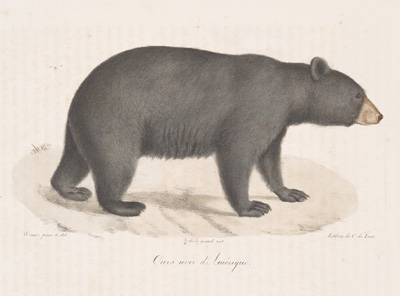

• Intro / Home
• Historical Neighbors
• Street and Backyard
Neighbors
• Park and Green Places
Neighbors
• Shore and Wetlands
Neighbors
• Salt and Freshwater
Neighbors
• Tiny Neighbors
• Unwelcome Neighbors
• Occasional and
Unexpected Neighbors
•
Wildlife Sighting Log
• Resources
• Hours and Tours
• Press Release
• NYPL HOME
| Historical Neighbors | |
In the 16th century, an estimated two million Black
Bears inhabited wooded areas throughout the continent. Now eliminated
from most of their former range, their numbers reduced to fewer
than 200,000 in the contiguous United States, Ursus americanus
nevertheless remains the best known and most widely distributed
of North American bears. They are common in rural locales not far
from New York City, and as suburban sprawl reduces available habitats,
bears often invade towns in search of food. Although they are primarily
herbivorous, Black Bears eat almost anything, including grasses,
berries, mushrooms, acorns, insects, and carrion. The bear depicted here resided in the enormous zoo of the National Museum of Natural History in Paris, known before 1793 as Jardin des Plantes and the Cabinet d’Histoire Naturelle, and during the monarchy as the Jardin et Cabinet du Roi. Other North American animals in this international menagerie included squirrels, Raccoons, Opossums, Bison, eagles, an Elk, and foxes, who produced young (an unusual event for captive animals during this period). Cuvier, the zoo’s superintendent, together with Geoffroy Saint-Hilaire, the museum’s professor of birds and mammals, described the zoo’s inhabitants in this extensive and lavishly illustrated catalog.
|
